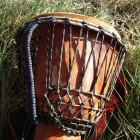Roots Jam 3: Arrangements for West African Drum & Dance
Why Roots Jam 3?
This volume, third in the Roots Jam series, continues my effort to record my own learning of West African drumming and to share it with others. Along with this learning of traditional rhythms and arrangements has come an interest in composing and arranging original pieces. The boundaries between “traditional” and “original” in this book are not totally distinct. There are a few original phrases in the collection of traditional rhythms, and the arrangements themselves are products of my own selection process; meanwhile many of the individual patterns in the “Original Compositions” come from traditional or other recorded sources, and are combined here in new arrangements.
Since the publication of Roots Jam 2 in 2002, I have moved from playing with a dance troupe in Nelson BC to the larger city of Victoria. Here I had the good fortune to connect right away with Byron and Lynn Weaver of Moondance Dynamic Arts, who were putting on West African dance classes, at a time when another drummer had also just arrived to help out with drum instruction and arrangements.
Jordan Zinovitch had been drumming for just four years, but with an intense learning curve under master teachers in New York (Bembe Bangoura, Ousmane Sylla) and Guinea (Gbanworo Keita). After weekly classes and several performances with Jordan for nine months, I traveled with Jordan to Portland, Oregon in 2003 for a weekend workshop with Famoudou Konate. That inspiring contact led to further study for both of us the following winter with Famoudou in Guinea, West Africa, as part of a larger group of 18 students, in the village of Sangbarala and the city of Conakry, where we drummed for five hours a day for the better part of a month.

Learning that material was a challenge which is ongoing. Again I have been fortunate to have the opportunity to put the learning into practice by playing for dance classes in Victoria, both with Lynn’s Moondance company and with Ilana Moon’s Dancing Moon Multicultural Arts Company. In the latter group I took on the additional responsibility of musical arrangement in coordination with Ilana’s choreography, and of instructing the other drummers of the ensemble in their parts. It has been my pleasure as well to share this knowledge with beginning drummers in a classroom setting, in locations ranging from Saltspring Island and Victoria to Koh Phangan, Thailand and Hobart, Tasmania.
In addition to the learning and inspiration from my primary teachers, Jordan and Famoudou, I have also had the opportunity since Roots Jam 2 to learn from Mamady Keita’s live workshops and written material, from Jordan Hanson’s drum classes in Victoria, and from the teachers of the Tambacounda drum camp in Mendocino, California: Moussa Traore, Abdoul Doumbia, Abdoulaye Diakite, and others. To my previous sources of written notation I have added the excellent books by Famoudou and Ibro Konate, Mamady Keita, Abdoul Doumbia, Serge Blanc, and Age Delbanco (see Resource list at the end of this volume).
My usual disclaimer is in order here: that I cannot guarantee that my own transcriptions are accurate from my live and recorded learning experiences, or even from other written sources (which themselves are not always reliable or consistent). Rather than attempt to be the authoritative recorder of certain teachers’ rhythms and arrangements, I aim to draw from the wide range of available material, to present here my own arrangements and choices of parts, while trying to remain faithful to the traditional forms as much as possible.
On one hand, the rhythms of the Malinke drum culture are almost infinite in their variation; on the other hand, out of those variations emerge certain constant and universal phrases and motifs. Not only are there the standard accompaniment parts for 4/4 and 12/8 timings; the solo phrases, too, often cross over between rhythms; and finally you come to the place where even these “different” time signatures blur one into the other. With all of the foregoing in mind, I have done my best to distill those variations that have come to me and to present them in what I hope is a pleasing arrangement – yet another variation in the tradition.
The primary inspiration for this book has been to collect and make accessible a cohesive and comprehensive body of material for use with dance classes or troupes. That application has its own set of rewards and limitations, geared as it is toward stage performance and highly choreographed dance and rhythm arrangements. I hope also that this rich musical tradition can inspire and feed more open-ended and participatory venues, in the mode of village-style dance, where the aim is powerful and joyful community celebration, and drummers and dancers can play together more freely.
